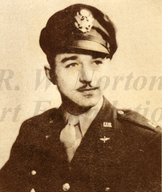
|

|
|
|
|
Robert was born in Great Falls, Montana, the son of Carl P. and Ester Meyers Horning. A grandfather, a German immigrant, joined the U.S. Army when he arrived in the 1880s, and fought Indians in Montana Territory. Robert spent much of his youth on his grandfather's ranch. He attended a one-room school before his family moved into the city, where he graduated from high school in 1940. Yearning to fly, he enlisted in the U.S. Army Air Corps. He found it was easy to adjust to military life. "You come from a German family, you're built in discipline, anyway," he says. There was no basic training at that time, he says, so he went directly to the 25th Pursuit Group, which was headed for the Philippines. Robert had fallen ill, however, and wasn't allowed to board the ship, an incident that actually may have saved his life. The Japanese would later capture that unit. Still too young for flight school, he was trained in airplane mechanics. Promoted to tech sergeant, he helped open schools at Sheppard Field in Wichita Falls, Texas, and Amarillo Army Air Field in Amarillo. He met Opal Cain at the USO, and they married on May 3, 1942. Robert entered officer's training, first at Valley Forge Military Academy and then at Yale University before going on to flight school. At advanced training at Moffit Field in San Francisco, he counted among his classmates the actor Jimmy Stewart and Chuck Yeager, later of test-pilot fame. He was sent to B-17 training at Geiger Field in Spokane, Washington. The crew of his plane named the airship "Cabin in the Skies," with an outhouse depicted on the nose. In addition to his work as an engineer, he filled in for crewmembers, such as an ill pilot or copilot. After final training in Montana, he flew in May of 1943 to Great Britain, where he joined the 390th Bombardment Group at Framingham. In twenty-five missions that he flew, no crewmember aboard "Cabin in the Skies" was lost. Robert returned to the States in July of 1945. "We flew the airplanes home and left them in a scrap heap in Springfield, Massachusetts," he says. He was scheduled to transfer to the Pacific and serve aboard B-29s, but peace was declared while he enjoyed a thirty-day leave. Robert went to work for Braniff Airlines but remained in the reserves and was called up during the Korean War. He was "checked out" in jets, flying the F-80 and then the F-84, a fighter-bomber. Based out of Taegu in central South Korea, he flew close air support by hitting bridges, supply depots, and railroads. He also served extra duty as a group engineer officer. Returning to the States, he flew a F89 for Air Defense Command. His post-Korea career took him to many duty stations, including Command and Staff School at Maxwell Air Force Base in Montgomery, Alabama. He served as inspector general for Strategic Air Command for a year and at Barksdale Air Force Base in 1965. During the Vietnam War he flew out of Thailand with the 355th Tactical Fighter Wing of F-105s. He returned after a year and served in the Washington, D.C. area as a deputy chief of staff for a general. Robert spent three years at supreme headquarters of at Mons near Brussells, Belgium. After retiring in 1975 he worked as executive director of the Shreveport Executive Association until 1986. His first wife passed away, and he married Rae Ogier in 2001. |


